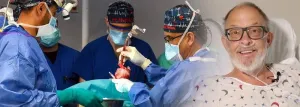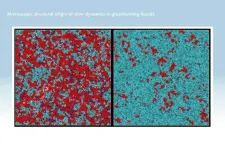(Press-News.org) Continuing significant advancements in the field of xenotransplantation, surgeon-scientists from the University of Maryland School of Medicine provided an extensive analysis on the second patient in the world to receive a genetically-modified pig organ. Lawrence Faucette, 58, received a pig heart at the University of Maryland Medical Center in 2023 to treat his end-stage heart failure. He lived for 40 days before choosing to forgo additional treatment after the transplant began to fail due to rejection.
The report documenting insights gleaned from Mr. Faucette’s experience, as the world’s second xeno heart transplant recipient, was published today in the journal Nature Medicine. The paper documents initial signs of rejection of the 10 gene-edited pig heart on the first biopsy performed about two weeks after the surgery. It provides important lessons learned and potential new pathways forward as xenotransplant surgeons prepare for upcoming clinical trials in the years ahead.
“We have taken another important step forward in the quest to address the global shortage of donor hearts, and we once again found that the porcine heart demonstrated excellent systolic and diastolic function during the initial weeks post-transplantation,” said study co-lead and first author Bartley P. Griffith, MD, who surgically transplanted the pig heart into both the first and second patient at UMMC. Dr. Griffith is the Thomas E. and Alice Marie Hales Distinguished Professor in Transplant Surgery, the Department of Surgery’s Vice Chair of Innovation, and Clinical Director of the Cardiac Xenotransplantation Program at UMSOM. “Thanks to the bravery of Mr. Faucette and his loving family, we have a clearer understanding of modifications we can make moving forward to achieve longer term success.”
Mr. Faucette had end-stage heart disease and was deemed ineligible for a traditional transplant with a human heart due to his pre-existing peripheral vascular disease and complications with internal bleeding. This transplant was the only option available for Mr. Faucette who was facing near-certain death from heart failure.
“We are humbled by our experience, not only because of what we have learned but also from witnessing the strength and grace of our two patients and their families,” said study co-lead and corresponding author Muhammad M. Mohiuddin, MD, Professor of Surgery, Program and Scientific Director of the Cardiac Xenotransplantation Program at UMSOM and President of International Xenotransplantation Association. “Their sacrifice yielded crucial scientific insights into how we and others should proceed to learn how to prevent graft failure from happening in future transplants.”
Through their investigation, the study authors determined that this case underscores the need for continued research to overcome challenges such as antibody-mediated rejection. Despite selecting a patient with low pre-existing anti-pig antibodies, the transplant team found a surge in these antibodies, which caused damage to the heart and ultimately led to graft failure. Further transplants may require more aggressive depletion and suppression of these antibodies. These investigations further elaborated the influence of other immune-mediated mechanisms in graft failure.
“Despite setbacks related to immunological rejection after a few weeks, xenotransplantation and living related organ donation remain our most viable pathways forward towards sustainable organ availability to meet the needs of our aging populations," said Mark T. Gladwin, MD, the John Z. and Akiko K. Bowers Distinguished Professor and Dean of UMSOM and Vice President for Medical Affairs, University of Maryland, Baltimore. "We certainly faced similar challenges in the early days of solid organ transplantation. Our physician-scientists continue to work towards a better understanding of how to prevent porcine organ rejection despite aggressive immunosuppression and early successful surgical and hemodynamic outcomes.”
Other UMSOM faculty co-authors of this study include: Avneesh K Singh, PhD, Alison Grazioli, MD, Kapil Saharia, MD, Andy Tully, MD, Javier Galindo, MD, Kapil K. Saharia, MD, Erik R. Strauss, MD, Patrick N. Odonkor, MD, Brittney Williams, MD, Henry J. Silverman, MD, Allen Burke, MD, Cinthia B. Drachenberg, MD,, Chris L. Wells, PT, PhD, Timm Dickfeld, MD, PhD, Susie N. Hong, MD, Albert J. Hicks III, MD, Manjula Ananthram, MD, Anuj Gupta, MD, Robert H. Christenson, PhD, Tianshu Zhang, PhD, and Bradley Taylor, MD.
“We continue to learn so much from these pioneering surgeries, and we are grateful to United Therapeutics for their support of our work as we help move the field of xenotransplantation closer to becoming a clinical reality,” said study co-author Christine Lau, MD, MBA, the Dr. Robert W. Buxton Professor, Chair of the Department of Surgery at UMSOM, and Surgeon-in-Chief at UMMC.
Added Bert W. O’Malley, MD, UMMC President and CEO: “The insights gained from Mr. Faucette’s journey, alongside the learnings from our first pig heart transplant recipient, serve as a beacon guiding our ongoing quest to overcome the hurdles of this transformative medical advancement. We continue to be inspired by Mr. Faucette, not only by his drive to advance the science of xenotransplantation but also by the gratitude he expressed to the UMMC team members who cared for him.”
Disclosures: United Therapeutics, Inc., provided funding to the University of Maryland Foundation to help defray the cost of this transplant. Revivicor, Inc provided the genetically-modified pig source for the organ, and Eledon Pharmaceuticals provided the Tegoprubart antibody.
About the University of Maryland School of Medicine
Now in its third century, the University of Maryland School of Medicine was chartered in 1807 as the first public medical school in the United States. It continues today as one of the fastest growing, top-tier biomedical research enterprises in the world -- with 46 academic departments, centers, institutes, and programs, and a faculty of more than 3,000 physicians, scientists, and allied health professionals, including members of the National Academy of Medicine and the National Academy of Sciences, and a distinguished two-time winner of the Albert E. Lasker Award in Medical Research. With an operating budget of more than $1.2 billion, the School of Medicine works closely in partnership with the University of Maryland Medical Center and Medical System to provide research-intensive, academic and clinically based care for nearly 2 million patients each year. The School of Medicine has nearly $600 million in extramural funding, with most of its academic departments highly ranked among all medical schools in the nation in research funding. As one of the seven professional schools that make up the University of Maryland, Baltimore campus, the School of Medicine has a total population of nearly 9,000 faculty and staff, including 2,500 students, trainees, residents, and fellows. The combined School of Medicine and Medical System ("University of Maryland Medicine") has an annual budget of over $6 billion and an economic impact of nearly $20 billion on the state and local community. The School of Medicine, which ranks as the 8th highest among public medical schools in research productivity (according to the Association of American Medical Colleges profile) is an innovator in translational medicine, with 606 active patents and 52 start-up companies. In the latest U.S. News & World Report ranking of the Best Medical Schools, published in 2023, the UM School of Medicine is ranked #10 among the 92 public medical schools in the U.S., and in the top 16 percent (#32) of all 192 public and private U.S. medical schools. The School of Medicine works locally, nationally, and globally, with research and treatment facilities in 36 countries around the world. Visit medschool.umaryland.edu
About the University of Maryland Medical Center
The University of Maryland Medical Center (UMMC) is comprised of two hospital campuses in Baltimore: the 800-bed flagship institution of the 11-hospital University of Maryland Medical System (UMMS) and the 200-bed UMMC Midtown Campus. Both campuses are academic medical centers for training physicians and health professionals and for pursuing research and innovation to improve health. UMMC's downtown campus is a national and regional referral center for trauma, cancer care, neurosciences, advanced cardiovascular care, and women's and children's health, and has one of the largest solid organ transplant programs in the country. All physicians on staff at the downtown campus are clinical faculty physicians of the University of Maryland School of Medicine. The UMMC Midtown Campus medical staff is predominately faculty physicians specializing in a wide spectrum of medical and surgical subspecialties, primary care for adults and children and behavioral health. UMMC Midtown has been a teaching hospital for 140 years and is located one mile away from the downtown campus. For more information, visit umm.edu.
Continuing significant advancements in the field of xenotransplantation, surgeon-scientists from the University of Maryland School of Medicine provided an extensive analysis on the second patient in the world to receive a genetically-modified pig organ. Lawrence Faucette, 58, received a pig heart at the University of Maryland Medical Center in 2023 to treat his end-stage heart failure. He lived for 40 days before choosing to forgo additional treatment after the transplant began to fail due to rejection.
The report documenting insights gleaned from Mr. Faucette’s experience, as the world’s second xeno heart transplant recipient, was published today in the journal Nature Medicine. The paper documents initial signs of rejection of the 10 gene-edited pig heart on the first biopsy performed about two weeks after the surgery. It provides important lessons learned and potential new pathways forward as xenotransplant surgeons prepare for upcoming clinical trials in the years ahead.
“We have taken another important step forward in the quest to address the global shortage of donor hearts, and we once again found that the porcine heart demonstrated excellent systolic and diastolic function during the initial weeks post-transplantation,” said study co-lead and first author Bartley P. Griffith, MD, who surgically transplanted the pig heart into both the first and second patient at UMMC. Dr. Griffith is the Thomas E. and Alice Marie Hales Distinguished Professor in Transplant Surgery, the Department of Surgery’s Vice Chair of Innovation, and Clinical Director of the Cardiac Xenotransplantation Program at UMSOM. “Thanks to the bravery of Mr. Faucette and his loving family, we have a clearer understanding of modifications we can make moving forward to achieve longer term success.”
Mr. Faucette had end-stage heart disease and was deemed ineligible for a traditional transplant with a human heart due to his pre-existing peripheral vascular disease and complications with internal bleeding. This transplant was the only option available for Mr. Faucette who was facing near-certain death from heart failure.
“We are humbled by our experience, not only because of what we have learned but also from witnessing the strength and grace of our two patients and their families,” said study co-lead and corresponding author Muhammad M. Mohiuddin, MD, Professor of Surgery, Program and Scientific Director of the Cardiac Xenotransplantation Program at UMSOM and President of International Xenotransplantation Association. “Their sacrifice yielded crucial scientific insights into how we and others should proceed to learn how to prevent graft failure from happening in future transplants.”
Through their investigation, the study authors determined that this case underscores the need for continued research to overcome challenges such as antibody-mediated rejection. Despite selecting a patient with low pre-existing anti-pig antibodies, the transplant team found a surge in these antibodies, which caused damage to the heart and ultimately led to graft failure. Further transplants may require more aggressive depletion and suppression of these antibodies. These investigations further elaborated the influence of other immune-mediated mechanisms in graft failure.
“Despite setbacks related to immunological rejection after a few weeks, xenotransplantation and living related organ donation remain our most viable pathways forward towards sustainable organ availability to meet the needs of our aging populations," said Mark T. Gladwin, MD, the John Z. and Akiko K. Bowers Distinguished Professor and Dean of UMSOM and Vice President for Medical Affairs, University of Maryland, Baltimore. "We certainly faced similar challenges in the early days of solid organ transplantation. Our physician-scientists continue to work towards a better understanding of how to prevent porcine organ rejection despite aggressive immunosuppression and early successful surgical and hemodynamic outcomes.”
Other UMSOM faculty co-authors of this study include: Avneesh K Singh, PhD, Alison Grazioli, MD, Kapil Saharia, MD, Andy Tully, MD, Javier Galindo, MD, Kapil K. Saharia, MD, Erik R. Strauss, MD, Patrick N. Odonkor, MD, Brittney Williams, MD, Henry J. Silverman, MD, Allen Burke, MD, Cinthia B. Drachenberg, MD,, Chris L. Wells, PT, PhD, Timm Dickfeld, MD, PhD, Susie N. Hong, MD, Albert J. Hicks III, MD, Manjula Ananthram, MD, Anuj Gupta, MD, Robert H. Christenson, PhD, Tianshu Zhang, PhD, and Bradley Taylor, MD.
“We continue to learn so much from these pioneering surgeries, and we are grateful to United Therapeutics for their support of our work as we help move the field of xenotransplantation closer to becoming a clinical reality,” said study co-author Christine Lau, MD, MBA, the Dr. Robert W. Buxton Professor, Chair of the Department of Surgery at UMSOM, and Surgeon-in-Chief at UMMC.
Added Bert W. O’Malley, MD, UMMC President and CEO: “The insights gained from Mr. Faucette’s journey, alongside the learnings from our first pig heart transplant recipient, serve as a beacon guiding our ongoing quest to overcome the hurdles of this transformative medical advancement. We continue to be inspired by Mr. Faucette, not only by his drive to advance the science of xenotransplantation but also by the gratitude he expressed to the UMMC team members who cared for him.”
Disclosures: United Therapeutics, Inc., provided funding to the University of Maryland Foundation to help defray the cost of this transplant. Revivicor, Inc provided the genetically-modified pig source for the organ, and Eledon Pharmaceuticals provided the Tegoprubart antibody.
About the University of Maryland School of Medicine
Now in its third century, the University of Maryland School of Medicine was chartered in 1807 as the first public medical school in the United States. It continues today as one of the fastest growing, top-tier biomedical research enterprises in the world -- with 46 academic departments, centers, institutes, and programs, and a faculty of more than 3,000 physicians, scientists, and allied health professionals, including members of the National Academy of Medicine and the National Academy of Sciences, and a distinguished two-time winner of the Albert E. Lasker Award in Medical Research. With an operating budget of more than $1.2 billion, the School of Medicine works closely in partnership with the University of Maryland Medical Center and Medical System to provide research-intensive, academic and clinically based care for nearly 2 million patients each year. The School of Medicine has nearly $600 million in extramural funding, with most of its academic departments highly ranked among all medical schools in the nation in research funding. As one of the seven professional schools that make up the University of Maryland, Baltimore campus, the School of Medicine has a total population of nearly 9,000 faculty and staff, including 2,500 students, trainees, residents, and fellows. The combined School of Medicine and Medical System ("University of Maryland Medicine") has an annual budget of over $6 billion and an economic impact of nearly $20 billion on the state and local community. The School of Medicine, which ranks as the 8th highest among public medical schools in research productivity (according to the Association of American Medical Colleges profile) is an innovator in translational medicine, with 606 active patents and 52 start-up companies. In the latest U.S. News & World Report ranking of the Best Medical Schools, published in 2023, the UM School of Medicine is ranked #10 among the 92 public medical schools in the U.S., and in the top 16 percent (#32) of all 192 public and private U.S. medical schools. The School of Medicine works locally, nationally, and globally, with research and treatment facilities in 36 countries around the world. Visit medschool.umaryland.edu
About the University of Maryland Medical Center
The University of Maryland Medical Center (UMMC) is comprised of two hospital campuses in Baltimore: the 800-bed flagship institution of the 11-hospital University of Maryland Medical System (UMMS) and the 200-bed UMMC Midtown Campus. Both campuses are academic medical centers for training physicians and health professionals and for pursuing research and innovation to improve health. UMMC's downtown campus is a national and regional referral center for trauma, cancer care, neurosciences, advanced cardiovascular care, and women's and children's health, and has one of the largest solid organ transplant programs in the country. All physicians on staff at the downtown campus are clinical faculty physicians of the University of Maryland School of Medicine. The UMMC Midtown Campus medical staff is predominately faculty physicians specializing in a wide spectrum of medical and surgical subspecialties, primary care for adults and children and behavioral health. UMMC Midtown has been a teaching hospital for 140 years and is located one mile away from the downtown campus. For more information, visit umm.edu.
END
Presenting a path forward for future genetically-modified pig heart transplants: lessons learned from second patient
UM School of Medicine researchers identify challenges to overcome to avoid rejection in future xenotransplants
2025-01-08
ELSE PRESS RELEASES FROM THIS DATE:
When the past meets the future: Innovative drone mapping unlocks secrets of Bronze Age ‘mega fortress’ in the Caucasus
2025-01-08
A Cranfield University, UK, academic has used drone mapping to investigate a 3000-year-old ‘mega fortress’ in the Caucasus mountains. Dr Nathaniel Erb-Satullo, Senior Lecturer in Architectural Science at Cranfield Forensic Institute, has been researching the site since 2018 with Dimitri Jachvliani, his co-director from the Georgian National Museum, revealing details that re-shape our understanding of the site and contribute to a global reassessment of ancient settlement growth and urbanism.
Fortress settlements in the South Caucasus appeared between 1500-500 BCE, and represent an ...
AI could improve the success of IVF treatment
2025-01-08
During IVF treatment, doctors use ultrasound scans to monitor the size of follicles - small sacs in the ovaries containing eggs - to decide when to give a hormone injection known as the ‘trigger’ to prepare the eggs for collection and ensure that they are ready to be fertilised with sperm to create embryos. The timing of the trigger is a key decision, as it works less effectively if the follicles are too small or too large at the time of administration. After the eggs are collected and fertilised by sperm, an embryo is then selected and implanted into the womb to hopefully lead to pregnancy.
Researchers used ‘Explainable ...
Moving in sync, slowly, in glassy liquids
2025-01-08
Tokyo, Japan – Glass might seem to be an ordinary material we encounter every day, but the physics at play inside are actually quite complex and still not completely understood by scientists. Some panes of glass, such as the stained-glass windows in many Medieval buildings, have remained rigid for centuries, as their constituent molecules are perpetually frozen in a state of disorder. Similarly, supercooled liquids are not quite solid, in the sense that their fundamental particles do not stick to a lattice ...
Climate change linked with worse HIV prevention and care
2025-01-08
Toronto, ON – New challenges in HIV prevention and care are emerging due to climate change, according to a review published earlier this month in Current Opinions in Infectious Disease.
Researchers from the University of Toronto analyzed 22 recent studies exploring HIV-related outcomes in the context of climate change and identified several links between extreme weather events and HIV prevention and care.
Climate change-related extreme weather events, such as drought and flooding, were associated with poorer HIV prevention outcomes, including ...
Exeter launches second round of global funding to tackle antifungal drug resistance
2025-01-08
A University of Exeter funding scheme designed to combat the global challenge of fungal antimicrobial resistance (fAMR) has announced a new call for applications.
The FAILSAFE project (Fungal AMR Innovations for LMICS: Solutions and Access For Everyone) is a groundbreaking initiative tackling antifungal drug resistance. The project aims to promote worldwide innovations to tackle the global health threat of fungal infections in humans, plants and animals increasingly growing resistant to available treatment.
Already, the FAILSAFE project has awarded more than £1.7 million in grants ...
Harnessing AI to respond to the global threat of antimicrobial resistance
2025-01-08
AMR is when microorganisms that cause infections, such as bacteria and viruses, change over time and no longer respond to antibiotic medicines.
It makes serious conditions such as HIV, tuberculosis and malaria more difficult to treat and increases the risk of severe illness, disease spread and death.
AMR particularly impacts low-to-middle-income countries where water quality is often poor and the spread environmental spread of AMR via wastes can be high.
In 2015 the World Health Organization (WHO) formulated a Global Action Plan to co-ordinate efforts to tackle AMR.
As a result, 194 WHO member states committed to developing country-specific ...
New findings may help researchers develop a grapefruit devoid of compounds that affect medication levels
2025-01-08
Grapefruit and pummelo contain compounds called furanocoumarins that may affect the blood levels of more than 100 prescription drugs, so that people taking these medications are advised to remove these fruits from their diets. Research published in New Phytologist reveals genetic information about the synthesis of furanocoumarins in different citrus plant tissues and species and provides new insights that could be used to develop grapefruit and pummelo that lack furanocoumarins.
The research indicates that the production of furanocoumarins in citrus ...
Advanced wearable robot eases heavy lifting and other injury-causing tasks for workers
2025-01-08
In research published in Advanced Intelligence Systems, scientists have developed an innovative, soft, wearable robot to help workers avoid job-related injuries while lifting, lowering, and carrying objects.
While many available wearable robots are limited to supporting a single degree of freedom of the body (meaning the body can only move in one direction at a given joint), the new robot, called WeaRo, operates through multiple degrees of freedom, allowing for complex movements.
In tests, WeaRo effectively reduced the muscle activation levels of lumbar, biceps, and triceps muscles by a maximum of 18.2%, 29.1%, and ...
Does job strain compromise long-term sleep quality?
2025-01-08
In a recent study published in the American Journal of Industrial Medicine, middle aged workers in the U.S. who reported high job strain at the start of the study experienced significantly more sleep disturbances over an average follow-up of nine years.
The study analyzed data from 1,721 workers, with an average age of 51 years, who participated in the Midlife in the United States (MIDUS) study. Sleep disturbances were assessed with an established scale, based on four sleep-related symptoms: trouble falling asleep, waking up during ...
Artificial intelligence–based method assesses depression in business leaders
2025-01-08
Researchers have developed a novel method to assess depression in CEOs by using machine learning models (a type of artificial intelligence) to analyze vocal acoustic features from conference call recordings. This innovative approach, detailed in an article published in the Journal of Accounting Research, provides insights into a mental health issue that often remains hidden in high-pressure executive roles.
The researchers examined how CEO depression is related to career outcomes, compensation, and incentives. Their findings suggest ...
LAST 30 PRESS RELEASES:
Deep ocean earthquakes drive Southern Ocean’s massive phytoplankton blooms, study finds
Without campus leftovers to pick through, the beaks of this bird changed shape during the pandemic
High-dose antibiotic does not reduce mortality in tuberculous meningitis
How many insects fly in the sky above the USA?
Could cheese protect your brain health?
Who faces more difficulty recovering from stroke?
Colliding galaxies create the brightest, fastest growing black holes at their center
New BrainHealth research reveals tradeoffs on sleep with cannabis use for chronic pain
Aging-US now on ResearchGate, enhancing visibility for authors and readers
'Molecular glue' stabilizes protein that inhibits development of non-small cell lung cancer
Mount Sinai Health System is recognized in 2025 Chime Digital Health Most Wired survey
From prey to predator: How carnivores spread beneficial fungi
Menopause symptoms may be frequent and have negative effects, according to female endurance athletes
US Congressmembers’ responses on X to mass shooting events differ along party lines
KAIST-UEL team develops “origami” airless wheel to explore lunar caves
Individual genetic differences render some therapies ineffective
Engineering dendritic cells boosts cancer immunotherapy
Sophisticated neuroimaging reveals PTSD in WTC responders is linked to measurable physical changes in brain structure
Health policy experts identify promising strategies for providing health care to homeless people
Study explores role of neutrophils in canine atopic dermatitis
Mayo Clinic researchers develop AI-ECG model to diagnose liver disease earlier
Heavy menstruation common among teenage girls – questionnaire reveals risk of iron deficiency
New study explores why open water swimming feels so powerful for midlife women
In echo of Jurassic Park, mosquitoes capture entire ecosystems in their blood meals
Marty Cooper, Illinois Tech Alumnus and ‘Father of the Cell Phone,’ Receives 2025 Marconi Society Lifetime Achievement Award
How to reduce the risk of lymphedema
NEJM Evidence and CIDRAP announce Public Health Alerts
New fossil study illuminates on the evolutionary success of frogs
Patient-specific human liver model to understand disease mechanisms
Confused by the doctor's questionnaire? U of A study suggests it's common
[Press-News.org] Presenting a path forward for future genetically-modified pig heart transplants: lessons learned from second patientUM School of Medicine researchers identify challenges to overcome to avoid rejection in future xenotransplants




